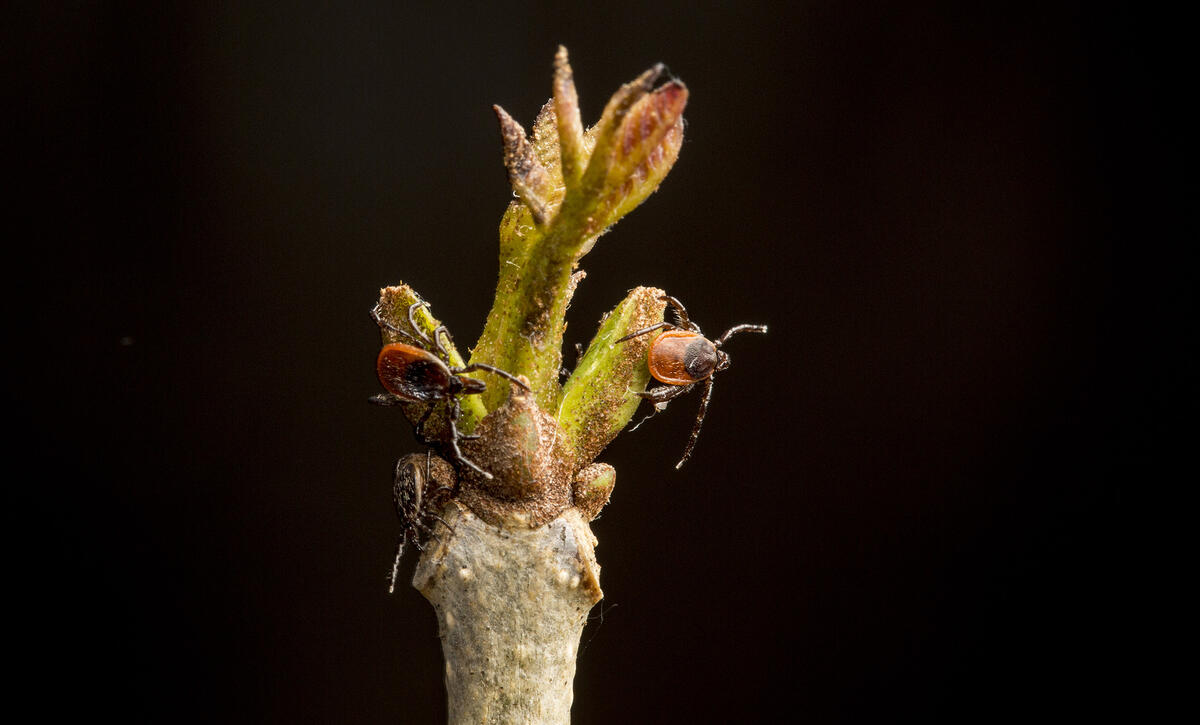
For more than 30 years, our team has been studying the complex interactions between variable acorn production, rodent populations, and ticks that carry Lyme disease. Our goal is to understand the environmental factors that influence Lyme disease occurrence, in order to predict when and where risk is greatest to humans, to guide public health interventions.
When this project began in 1991, there was little recognition of the role ecology plays in infectious diseases. There was also a widespread belief that white-tailed deer were the most important factor shaping Lyme disease risk. Our work has challenged both of those misconceptions, leading to more effective public health measures.
Environmental risk indicators for Lyme disease
Every year, there are more than 300,000 new cases of Lyme disease in the US. If left undiagnosed and untreated, people with Lyme disease may develop severe symptoms that are hard to treat.
Lyme disease is caused by the bacterium Borrelia burgdorferi. In North America, this bacterium is primarily transmitted to people when they are bitten by blacklegged ticks (Ixodes scapularis). Ticks are born free of the Borrelia burgdorferi bacteria; they acquire it when they feed on infected animals.
Acorn production by oak trees can predict the risk of human exposure to Lyme-disease almost two years in advance. Acorns are an important food resource for white-footed mice, the most efficient reservoir for Borrelia burgdorferi. In years when oaks have large acorn crops, more mice survive the winter, and thrive the following spring and summer. An abundant mouse population means that newly hatched larval ticks are more likely to encounter and feed on mice, acquiring the Borrelia bacteria. When infected larval ticks molt into nymphs a year later, they can pass on the bacteria if they bite a human.

What we have found
With support from the National Science Foundation’s Long Term Research in Environmental Biology Program, we’ve been collecting a wide variety of data in Dutchess County, NY. These include:
- acorn production
- population dynamics of white-footed mice, eastern chipmunks, tree squirrels and deer
- population dynamics of larval, nymphal, and adult blacklegged ticks
- infection prevalence of ticks with Lyme disease bacteria and other tick-borne pathogens
- presence of rodent predators
- tick responses to specific climatic variables
Our data revealed and continue to strengthen the link between acorn pulses and Lyme disease incidence. As a result, we have proposed that acorn production could be used to alert the public when years of high Lyme-disease risk are anticipated.
Over time, our project has also uncovered weak links between Lyme disease risk and deer abundance as well as certain climatic variables, such as unusually warm and dry winter or spring conditions.
In addition, we have learned that biodiversity of mammals, including foxes, bobcats, raccoons and opossums, can help to reduce Lyme disease risk. Our work supports two mechanisms for this effect. The first is direct predation, where hunting by bobcats and foxes reduces populations of rodents that carry Borrelia burgdorferi. But not all predators are equally effective. Interestingly, we saw higher tick infection with pathogens in areas where coyotes predominate — likely because the coyotes displace smaller predators such as foxes, and are less likely to feed on rodents, favoring larger prey instead.
The second mechanism suggests that raccoons and opossums — which are less effective than rodents at spreading the Borrelia pathogen — provide an alternative blood meal for the ticks, reducing the number that acquire the pathogen. Opossums in particular are highly effective at killing ticks that try to feed on them, potentially reducing both tick abundance and infection prevalence.
As we learn more and more from our long-term data, our methods and hypotheses evolve and our understanding of the ecological dynamics of Lyme disease grows broader and deeper.

Continuing research on food webs, climate variables, and real-time forecasting of tick populations
While we continue to collect the project’s core data, we recently added camera traps to our study plots to better understand the mechanisms by which predators are influencing rodent populations and tick abundance.
We are also delving deeper into how climate variables influence tick-borne disease risk. Each year, at three sites from northern New York to eastern North Carolina, we are placing ticks inside mesh field enclosures in order to assess how temperature, humidity, and soil moisture impact tick survival and abundance. We also deploy these enclosures at our sites at the Cary Institute.
Our 30-year study has revealed that the forest composition in Dutchess County is changing, with oak species gradually being replaced by maples. It will be interesting to observe how this change in composition influences rodent populations and Lyme disease incidence, given that maple seeds form another (albeit lower quality) food source for rodents. We plan to evaluate the relative importance of oak and non-oak species in Lyme disease risk. Understanding these dynamics is important because tick-borne diseases are now expanding into areas where oaks are less abundant, including northern New York, New England, upper Midwest, and eastern Canada.
Our team is also developing real-time forecasting of tick populations. Informed by our long-term data on mouse population size, weather variables, and tick life stages, our ecological forecast model was able to predict tick population fairly well when we tested it on recent data that had not been included in building the model. Our next step will be to test the model by forecasting future tick abundance, both at our current plots and in a new location in Harvard Forest.
Public awareness is currently the best tool to prevent, diagnose, and treat Lyme disease in a timely manner. The most dangerous scenarios occur when Lyme disease spreads to an area where there is low awareness in the general public and healthcare communities. Generating forecasts and understanding the ecological dynamics that underpin the spread of Lyme disease are key to understanding when and where the risk is highest, and which areas may be at risk next. Our hope is that cultivating these advanced warnings will give public health officials time to mobilize, spread awareness, and protect local populations.
- Publications
Funder

